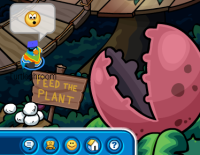Welcome to the Club Penguin Wiki! Log in or Create an account to join the community!
Snowball Eating Plant


The Snowball Eating Plant is a fictional venus fly trap parody in Club Penguin, found at the Tree House during the Adventure Party. By far the most amusing feature of the room, throwing snowballs into its mouth causes it to consume them and eventually grow. If one keeps feeding the plant enough snowballs, it will begin to grow. The more snowballs granted, the more growth from the plant.
As the plant grows in size, the chomping sound it makes also becomes louder. The plant can grow large enough to fill the southeastern sector if fed properly. At its maximum limit, however, the plant will burp and deflate itself to original size, ready for a second course of frozen precipitation.
Anatomy
The plant is red in color, with flattened teeth. In the real world, that would mean the plant is a herbivore (plant eater), but in this plant's case, it is for capturing and retaining snowballs inside itself. The plant seems to have warm insides because it melts snowballs upon contact. It is an audible creature, making notable chomping sounds and its loud burp after reaching maximum growth.
Water is essential to its survial, and the plant depends on penguins for its survival. Its only source of liquid is via snowballs, considering it hangs in trees and lacks a root system. This key trait of the Snowball Eating Plant indicates a symbiotic relationship. The plant depends on penguins for its food (snowballs) and the penguins benefit from feeding the plant by obtaining amusement.
Trivia
- It is unknown how the Snowball Eating Plant survives in the frigid subzero temperatures of the Antarctic (and Club Penguin).
- It is also unknown how the plant manages to stay aloft in the trees when at maximum size, and why it doesn't propel itself downward when letting out such loud and forceful belching.